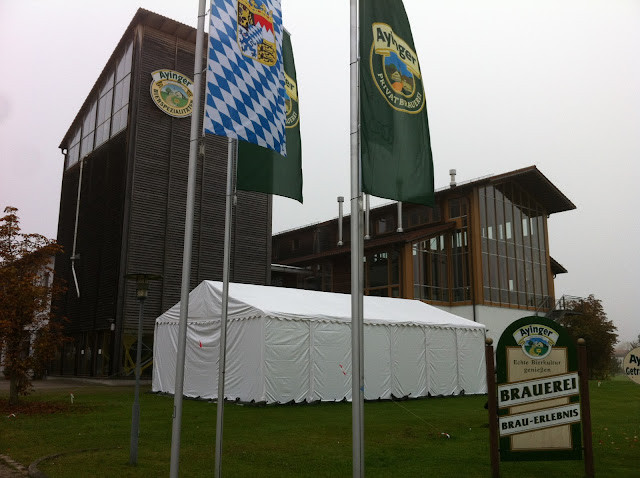Weizens on the Rise Around Munich
MUNICH. Germany has more intact regional brewing than any country I know, but Munich over-punches for its weight: dunkel and helles are de rigeur, oktoberfestbier the most famous, but weizens are in the ascendancy. Yesterday I visited Weihenstephan and Ayinger and for different reasons, the story was the same (I'm down to singular pronouns now--Sally flew home in the morning from an airport conveniently close to Weihenstephan.)
Weihenstephan is of course synonymous with banana and clove. The brewery is located on a hill and the university part of things is most dominant. That part of Weihenstephan includes food degrees and has continued to grow long past the parking needs, and I spent a half hour trawling the lots for a sliver of space. The campus is draped over a hill and the brewery is at the top: of course. Since it dates back nearly a millennium, brewers used cellars beneath the brewery to age their beer. A student of the school led our tour and it was the best by far I have ever heard given to the public--brewing arcana reduced to pithy, comprehensible descriptions. Every time I asked a question, the guide nodded and told me to wait--he was getting to that.
(There are two degrees available. The first is the brewmaster's, a three-year program. You can stay and get your brewing engineer degree--like a masters--in one more. By law, a brewery must employ a credentialed brewer, and Weihenstephan is the most famous of the several German schools. Whether the best is a matter I'll leave to others.)
Weihenstephan is a super-modern brewery and as you might expect, sort of the model for current practices. They do a double decoction mash, which is still common if not standard, and ferment all their beers in cylindriconicals. It is, in this way, a bit of a boring tour. (In other ways, like its university location and the fact that it's one of only three (I think) state-owned breweries, it is more so.)
What I found interesting was how quickly the brewery is growing even in the face of overall declining sales. We watched a brand-new video that mentioned 300,000 hectos of annual production; our guide said the earlier, 5-year-old video, quoted 230,000. And this is fueled by weizen--80% of production.
Weihenstephan is located just north of Munich in Freising; after my tour I zipped down to Aying, just a bit south of Munich. It's a very charming little town, and the old brewery is located just across the road from the iconic onion-domed church they put on their labels. It's a family-owned brewery and beginning about 20 years ago, the owners were deliberating about whether to call it a day or expand. They expanded, a few turns down the road, and built a brand-new brewery in 1999.
It's always interesting to see what a traditional brewery does during expansions. In Ayinger's case, they went the Adnam's route--super state-of-the-art and ecological. With one big exception: open fermenters for the weizen. (They scrapped decoction as well, calling it unnecessary, old-fashioned, expensive, and energy-intensive. Again, take any debate on that point in comments.)
The primary fermenters are encased in a glass cube to prevent--or forestall--microbiological mischief, but Ayinger thinks its an important part of building flavor, so this tradition they preserved. (Again, on the subject of open fermentation, debate among yourselves--I'll try to remain journalistically neutral here.)
Ayinger makes about a third as much as Weiheinstephan, but weizen's proportion has gone from the single digits to almost 30%. (Americans like me know the brewery for its legendary Celebrator Doppelbock.)
Fascinating stuff. Yesterday I mentioned how much I like the scarce-America helleses and dunkels. I wonder, will they one day be scarce in Munich?
Errata: I totally spaced taking iPhone photos at Weihenstephan--these are Ayinger.



